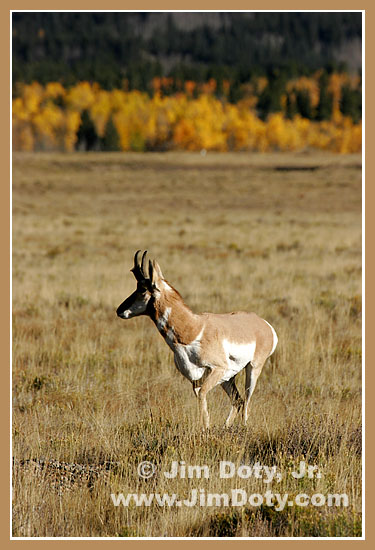MEMORY CARD QUESTIONS Antelope, South Park, Colorado. Photo copyright (c) Jim Doty, Jr.
Antelope, South Park, Colorado. Photo copyright (c) Jim Doty, Jr.Recently I was asked two questions about brands, reliability, and speed of memory cards for use in digital cameras. The Q&A follows.
Q. I have been searching for places online that will give me some good info on what kind of memory card(s) to purchase if and when I take the plunge with a Canon Rebel XT, and I'd appreciate some help from you. I usually shoot at air shows, static and flying subjects, in the hopes that a few images can be culled to be enlarged to 8x10s.
When it comes to figuring out what kind of memory card to buy, I am on sensory overload. High speed? Flash cards? 512 mb, or 1 gig? I don't need infinite memory, but would like the option to exploit the XT's 3 fps feature as high-priced aircraft streak overhead. Any insights you can offer will be greatly appreciated.A. I use Lexar and SanDisk CF (CompactFlash) cards and I have had no problems with them. They are both well respected brands. I have had problems with other brands. The faster versions of these cards do work a little faster in some of the more recent cameras. I can't say if that would be true for the Digital Rebel XT. Personally, I don't think it is worth the money to buy the fastest cards out there.
The size card you use (in terms of memory) is a matter of personal taste. It is a choice between how often you want to change cards, versus how many photos you are willing to risk. Bigger cards mean less card swapping. BUT, like all electronic devices, memory cards will eventually fail. The bigger the cards you use, the more photos you risk if a card fails and you can't retrieve the photos.
I do check my LCD from time to time to make sure all is ok, but that is no guarantee. I took a few photos at the end of a personal shoot using an off brand microdrive. Everything looked ok on the LCD. The next day, the camera couldn't write to the microdrive and the prior day's photos (not too many fortunately) were not recoverable.
I tend to use mostly 1-GB CF cards. For critical stuff, I use two cameras so if one card dies, I have similar photos on another card in the other camera.
If you will burn your photos to a CD, the photos on one 512 MB CF card will burn nicely to one CD. If you will burn your photos to DVDs, you can burn the photos on four 1-GB cards (or two 2-GB cards) to one DVD. This may be of less importance than the other considerations mentioned above.
Q. You mentioned in your previous answer to me that you used Lexar and Sandisk products. Well, now that I am focusing on this aspect of digital photography, I see myriad choices. While I understand the difference between 256mg and 1 gig, what confuses me is the difference between standard speed, 40X high speed and 80X high speed. Of course, the prices go up accordingly. But what exactly does the "speed" and the 40X and 80X mean when the subject is media cards? Thanks again for your help.A. 1x is usually defined as a write speed of 150 kB/s. Therefore, 20x, 40x and 80x cards should be able to record data at around 3 MB/s, 6 MB/s, and 12 MB/s respectively.
The catch is that is the speed at which the CARD can receive and record data, not the rate at which any given CAMERA can send data to the card. A Digital Rebel or a Canon 10D don't write any faster to a fast card than a slow card due to the camera technology.
A Canon 20D can write faster to a faster card, but not fast enough to make an 80x card worth the money, at least not for me and the way I take pictures.
Since most cameras have a buffer, you can take pictures as fast as you want and the card speed doesn't matter so long as you don't fill the camera buffer. Once the buffer is full, the write speed of the camera to the card becomes important, as well as the speed the card can receive data.
In real world use, I don't see much difference in using a 20x versus a 40x card in my Canon 20D, but that is because I rarely fill the buffer, even in fast sporting events. I rarely need to shoot 23 or more photos as fast as the camera will go.
Will an 80x card have an advantage over a 40x card? Only if you fill your camera's buffer, and then the write speed of the camera is more of a factor than the speed of the card. So the advantage is less than the numbers would indicate.
The same is true for 20x and 40x cards. I use both and the "real world" advantage of the faster cards is less than the "theoretical" advantage the numbers would indicate. I am happy with either.